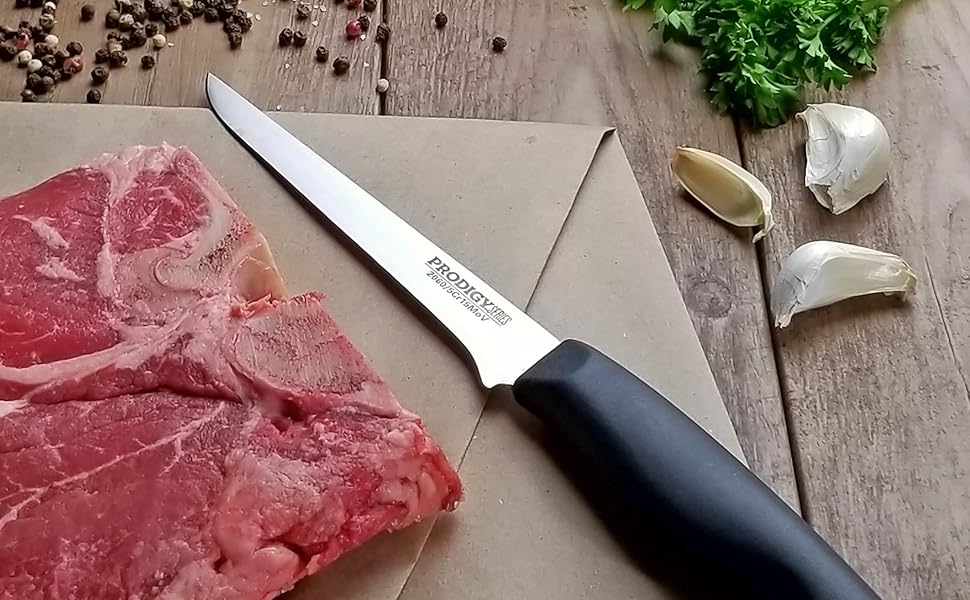The boning knife for home kitchens is a versatile tool that every cooking enthusiast should consider adding to their collection. This article will guide you through everything you need to know about boning knives, from their types and uses to maintenance tips. By understanding the intricacies of this essential kitchen tool, you can enhance your culinary skills and make meal preparation a breeze.

What is a Boning Knife?
A boning knife is a specialized kitchen knife designed for removing bones from meat, poultry, and fish. Its unique shape, featuring a narrow and flexible blade, allows for precision cutting and maneuverability around bones and joints. This makes it an ideal tool for tasks that require detailed and delicate cutting.
Types of Boning Knives
Flexible Boning Knives
Flexible boning knives are perfect for filleting fish and working with delicate meats. Their pliable blades can easily navigate around bones, ensuring minimal waste.
Stiff Boning Knives
Stiff boning knives provide more control and are ideal for tougher meats such as beef and pork. They allow for precise cuts, making them perfect for deboning larger cuts of meat. Learn more about the benefits of a stiff boning knife.
Choosing the Right Boning Knife
When selecting a boning knife for home kitchens, consider the type of meat you frequently work with. If you often prepare fish, opt for a flexible blade. For larger, tougher cuts of meat, a stiff blade may be more suitable.
Using a Boning Knife
How to Hold a Boning Knife
Proper grip is essential for precision and safety. Grip the handle firmly with your dominant hand, ensuring your fingers are away from the blade. For detailed instructions, visit our guide on boning knife grip styles.
Techniques for Deboning
Deboning requires practice and patience. Start by identifying the bone’s location and carefully cutting around it. Use the knife’s tip to separate the meat from the bone, following the natural contours. For a detailed guide on deboning fish, check out this comprehensive resource.
Maintaining Your Boning Knife
Cleaning and Storage
After each use, wash your boning knife with warm soapy water and dry it immediately to prevent rust. Store it in a knife block or magnetic strip to protect the blade.
Sharpening Tips
Regular sharpening is crucial for maintaining the knife’s edge. Use a sharpening stone or honing rod to keep the blade sharp and efficient.
Benefits of Using a Boning Knife
Using a boning knife in your home kitchen offers numerous advantages, including improved precision, reduced waste, and enhanced cooking efficiency. Its specialized design allows you to tackle various culinary tasks with ease.
Common Mistakes to Avoid
Avoid using a boning knife for tasks it isn’t designed for, such as cutting through bones or frozen foods, as this can damage the blade. Additionally, improper storage can lead to dullness or rust.
Frequently Asked Questions
What is the primary use of a boning knife?
A boning knife is primarily used for removing bones from meat, poultry, and fish with precision.
Can a boning knife be used for filleting fish?
Yes, a flexible boning knife is ideal for filleting fish due to its pliable blade.
How do I maintain the sharpness of my boning knife?
Regular sharpening with a stone or honing rod, along with proper cleaning and storage, will help maintain the knife’s sharpness.

Conclusion
The boning knife for home kitchens is an invaluable tool for anyone looking to improve their cooking skills. By understanding the different types, uses, and maintenance techniques, you can make the most of this versatile kitchen knife and enjoy a seamless cooking experience.
This article contains affiliate links. We may earn a commission at no extra cost to you.


